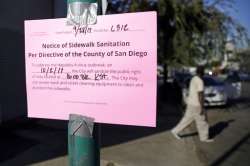California declares emergency amid Hepatitis A outbreak
California has declared a state of emergency to deal with deadly hepatitis A outbreak that has taken 18 lives in San Diego County and to combat vaccine shortage.

California Governor Jerry Brown on Friday declared a state of emergency to combat a hepatitis A outbreak that has claimed 18 lives in San Diego.
Brown said the federally-funded supply of vaccines is inadequate. His proclamation allows the state to buy vaccines directly from manufacturers and distribute them.
The declaration “allows us to move very swiftly,” Dr. Gil Chavez, epidemiologist at the California Department of Public Health, told reporters. He said the state would place an order Monday or Tuesday and supplies would reach the state soon after.
California has distributed 81,000 federally-funded vaccine doses since the outbreak began and local jurisdictions have acquired more but the supply is insufficient, Chavez said.
California is experiencing the largest hepatitis A outbreak in the United States transmitted from person to person — instead of by contaminated food — since the vaccine became available in 1996. The state says the majority affected are homeless, using drugs or both.
There have been 576 cases throughout California, including 490 in San Diego County, 71 in Santa Cruz County and eight in Los Angeles County. Out of those, 386 people have been hospitalized, including 342 in San Diego, 33 in Santa Cruz and six in Los Angeles. No deaths have been reported outside San Diego County.
U.S. Rep. Darrell Issa on Friday called on the federal government to provide emergency funding to halt the spread of hepatitis A. He said the outbreak has brought statewide totals to three times the number of reported cases in 2015.
“We cannot wait until more communities are infected and impacted before taking action,” the San Diego-area Republican wrote to the U.S. Health and Human Services Department and the Centers for Disease Control and Prevention.
In a statement, the CDC said it assigned officials to San Diego in May for five weeks to help identify how the infection spread and prevent additional cases. The agency said it continues to advise health care workers and volunteers.
San Diego County reported an outbreak in March as it grapples with a growing homeless population. The first cases were traced back to November.
Santa Cruz County reported its first cases the following month, and San Diego and Los Angeles counties declared local health emergencies in September.
The outbreak was caused by strains of the 1B genetic subtype, which is rare in the United States and more commonly found in the Mediterranean and South Africa. It is spread through contact with feces, putting people with inadequate access to sanitation at highest risk.
In addition to vaccination, frequent handwashing is recommended.